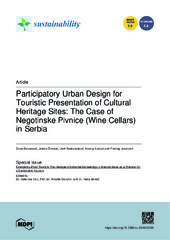Приказ основних података о документу
Participatory Urban Design for Touristic Presentation of Cultural Heritage Sites: The Case of Negotinske Pivnice (Wine Cellars) in Serbia
| dc.creator | Ðukanović, Zoran | |
| dc.creator | Živković, Jelena | |
| dc.creator | Radosavljević, Uroš | |
| dc.creator | Lalović, Ksenija | |
| dc.creator | Jovanović, Predrag | |
| dc.date.accessioned | 2023-11-14T20:48:22Z | |
| dc.date.available | 2023-11-14T20:48:22Z | |
| dc.date.issued | 2021 | |
| dc.identifier.issn | 2071-1050 | |
| dc.identifier.uri | https://raf.arh.bg.ac.rs/handle/123456789/1475 | |
| dc.description.abstract | The growing perception of heritage as a public commodity encourages rural communities to recognize their natural and cultural heritage as a potential for tourism development. This creates the need for an appropriate presentation of heritage sites that ensures that their cultural and natural assets are appreciated and protected. “Negotinske pivnice” are cultural heritage sites in Serbia, nominated for the UNESCO World Heritage List. They are architectural complexes of wine cellars in rural region with a long tradition in wine production and industry and are unique in terms of their settlement structure. This emphasizes the spatial dimension of their interpretation and presentation, and highlights the importance of urban design for their sustainable use for tourism. Based on understanding urban design both as a process and a product, and cultural heritage site as a place, we argue that participatory urban design contributes to appropriate heritage presentation by widening design knowledge base to include local communities’ lay knowledge. Following the case study methodology, we explored the relationships between participatory process, the knowledge gained, and urban design solutions for presentation of cultural heritage sites as living places in “Wine Cellars of Negotin Participatory Urban Design” project. The research reveals that the wider knowledge base affects urban design at both strategic and project levels and sets the grounds for diverse presentation forms through which harmonization of heritage protection and touristic presentation is possible. | sr |
| dc.language.iso | en | sr |
| dc.publisher | MDPI | sr |
| dc.relation | info:eu-repo/grantAgreement/MESTD/inst-2020/200090/RS// | sr |
| dc.rights | openAccess | sr |
| dc.rights.uri | https://creativecommons.org/licenses/by/4.0/ | |
| dc.source | Sustainability | sr |
| dc.subject | presentation of cultural heritage | sr |
| dc.subject | tourism | sr |
| dc.subject | urban design | sr |
| dc.subject | participation | sr |
| dc.subject | wine cellars | sr |
| dc.title | Participatory Urban Design for Touristic Presentation of Cultural Heritage Sites: The Case of Negotinske Pivnice (Wine Cellars) in Serbia | sr |
| dc.type | article | sr |
| dc.rights.license | BY | sr |
| dcterms.abstract | Јовановић, Предраг; Радосављевић, Урош; Живковић, Јелена; Ðукановић, Зоран; Лаловић, Ксенија; | |
| dc.rights.holder | 2021 by the authors. Licensee MDPI, Basel, Switzerland | sr |
| dc.citation.volume | 13 | |
| dc.citation.issue | 18 | |
| dc.citation.spage | 10039 | |
| dc.description.other | This article belongs to the Special Issue Emergency-Proof Tourism: The Heritage of Industrial Archaeology in Internal Areas as a Potential for a Sustainable Tourism, Edited by Dr. Valentina Talu, Prof. Dr. Arnaldo Cecchini and Dr. Nađa Beretić | sr |
| dc.identifier.doi | 10.3390/su131810039 | |
| dc.identifier.fulltext | http://raf.arh.bg.ac.rs/bitstream/id/5041/sustainability-13-10039-with-cover.pdf | |
| dc.type.version | publishedVersion | sr |

